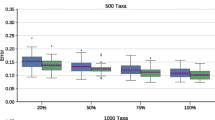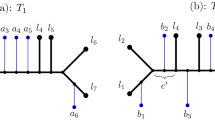Abstract
This work presents the application of the omni-aiNet algorithm—an immune-inspired algorithm originally developed to solve single and multi-objective optimization problems—to the reconstruction of phylogenetic trees. The main goal here is to automatically evolve a population of phylogenetic unrooted trees, possibly with distinct topologies, by minimizing at the same time two optimization criteria: the minimum evolution and the mean-squared error. This proposal generates, in a single run, a set of non-dominated solutions that represent the trade-offs of the two conflicting objectives, and gives the user the possibility of having distinct explanations for the differences observed at the terminal nodes of the trees. A series of experimental results is also reported in this work, in order to illustrate the effectiveness of the proposal and its capability to overcome the restrictive feedback provided by the application of well-known algorithms for phylogenetic reconstruction, such as the Neighbor Joining. Besides, the methodology presented in this work is compared to the popular NSGA-II algorithm, also modified to solve phylogenetic reconstruction problems.























Similar content being viewed by others
Notes
These two criteria were selected in this work because they are two of the most popular ones in the algorithms for phylogenetic reconstruction based on distance matrices. However, the proposed methodology can be easily extended to consider two or more different criteria.
References
Smith JM (1993) The theory of evolution. Cambridge University Press, Cambridge
Darwin C (1859) On the origin of species by means of natural selection, or the preservation of favoured races in the struggle for life. John Murray, London
Felsenstein J (2004) Inferring phylogenies. Sinauer Associates, Suderland
Kidd KK, Sgaramella-Zonta LA (1971) Phylogenetic analysis: concepts and methods. Am J Hum Genet 23:235–252
Bulmer M (1991) Use of the method of generalized least squares in reconstructing phylogenies from sequence data. Mol Biol Evol 8:868–883
Saitou N, Nei M (1987) The neighbor-joining method: a new method for reconstructing phylogenetic trees. Mol Biol Evol Evolution 4(4):406–425
Takahashi K, Nei M (2000) Efficiencies of fast algorithms of phylogenetic inference under the criteria of maximum parsimony, minimum evolution, and maximum likelihood when a large number of sequences are used. Mol. Biol. Evol. 17(8):1251–1258
Eschenauer H, Koski J, Osyczka A (1990) Multicriteria design optimization: procedures and applications. Springer, Berlin
Statnikov RB, Matusov JB (1995) Multicriteria optimization and engineering. Chapman & Hall, New York
Miettinen KM (1999) Nonlinear multiobjective optimization. Kluwer, Boston
Ehrgott M (2005) Multicriteria optimization. Springer, Berlin
Deb K (2001) Multi-objective optimization using evolutionary algorithms. Wiley, Chichester
Coello Coello CA, Van Veldhuizen DA, Lamont GB (2002) Evolutionary algorithms for solving multi-objective problems. Kluwer, New York
Coello Coello CA, Cruz Cortes N (2005) Solving multiobjective optimization problems using an artificial immune system. Genet Program Evol Mach 6:163–190
Coelho GP, Von Zuben FJ (2006) omni-aiNet: an immune-inspired approach for omni optimization. In: Proceedings of the fifth international conference on artificial immune systems, Oeiras, Portugal, September 2006, pp 294–308
Coelho GP, da Silva AE, Von Zuben FJ (2007) Evolving phylogenetic trees: a multiobjective approach. In: Proceedings of the Brazilian symposium on bioinformatics. Angra dos Reis, Brazil, August 2007, pp 113–125
Nei M, Kumar S (2000) Molecular evolution and phylogenetics. Oxford University Press, New York
Deb K, Pratap A, Agarwal S, Meyarivan T (2002) A fast and elitist multiobjective genetic algorithm: NSGA-II. IEEE Trans Evol Comput 6(2):182–197
Poladian L, Jermiin LS (2004) What might evolutionary algorithms (EA) and multi-objective optimisation (MOO) contribute to phylogenetics and the total evidence debate. In: Proceedings of the genetic and evolutionary computing conference (GECCO 2004). Seattle
Poladian L, Jermiin LS (2006) Multi-objective evolutionary algorithms and phylogenetic inference with multiple data sets. Soft Comput 4(10):359–368
Huelsenbeck JP, Crandall KA (1997) Phylogeny estimation and hypothesis testing using maximum likelihood. Annu Rev Ecol Syst 28:437–466
Holmes SP (1999) Phylogenies: an overview. Stat Genet 112:81–119
Day WHE (1987) Computational complexity of inferring phylogenies from dissimilarity matrices. Bull Math Biol 49:461–467
Billera LJ, Holmes SP, Vogtmann K (2001) Geometry of the space of phylogenetic trees. Adv Appl Math 27(4):733–767
Roch S (2006) A short proof that phylogenetic tree reconstruction by maximum likelihood is hard. IEEE/ACM Trans Comput Biol Bioinf 3(1):92
Sneath PHA, Sokal RR (1973) Numerical taxonomy. Freeman, San Francisco
Fitch WM, Margoliash E (1967) Construction of phylogenetic trees. Science 155:279–284
Saitou N, Imanishi T (1989) Relative efficiencies of the Fitch-Margoliash, maximum-parsimony, maximum-likelihood, minimum-evolution, and neighbor-joining methods of phylogenetic tree construction in obtaining the correct tree. Mol Biol Evol 6(5):514–525
DasGupta B, He X, Jiang T, Li M, Tromp J, Zhang L (1997) On distances between phylogenetic trees. In: Proceedings of the 8th annual ACM—SIAM symposium on discrete algorithms, pp 427–436
Brodal GS, Fagerberger R, Pedersen CNS (2004) Computing the quartet distance between evolutionary trees in time O(n.log(n)). Algorithmica 38:377–395
DasGupta B, He X, Jiang T, Li M, Tromp J, Zhang L (2000) On computing the nearest neighbor interchange distance. In: Du D-Z, Pardalos PM, Wang J (eds) Discrete mathematical problems with medical applications, vol 55 of DIMACS series in discrete mathematics and theoretical computer science. Am Math Soc, pp 125–143
Bryant D (2003) A classification of consensus methods for phylogenetics. In: Janowitz MF, Lapoint FJ, Morris FR, Mirkin B, Roberts FS (eds) Bioconsensus, vol 61 of DIMACS series in discrete mathematics and theoretical computer science. Am Math Soc, pp 163–184
Robinson DF, Foulds LR (1981) Comparison of phylogenetic trees. Math Biosci 53:131–147
Edgeworth FY (1881) Mathematical physics. P. Keagan, London
Pareto V (1896) Cours D’Economie politique. F. Rouge, Lausanne
Goldberg DE (1989) Genetic algorithms in search, optimization and machine learning. Addison-Wesley Publishing Company, Reading
Bäck T, Fogel DB, Michalewicz Z (eds) (2000) Evolutionary computation 1: basic algorithms and operators Institute of Physics Publishing, Bristol
Bäck T, Fogel DB, Michalewicz Z (eds) (2000) Evolutionary computation 2: advanced algorithms and operators. Institute of Physics Publishing, Bristol
Coello Coello CA (1999) A comprehensive survey of evolutionary-based multiobjective optimization techniques. Knowl Inf Syst 1(3):129–156
Coello Coello CA (2006) Evolutionary multi-objective optimization: a historical view of the field. IEEE Comput Intell Mag 1(1):28–36
Zitzler E, Thiele L (1999) Multiobjective evolutionary algorithms: a comparative case study and the strength Pareto approach. IEEE Trans Evol Comput 3(4):257–271
Corne DW, Knowles JD, Oates MJ (2000) The Pareto envelope-based selection algorithm for multiobjective optimization. In: Proceedings of the parallel problem solving from nature VI conference, pp 839–848
Knowles JD, Corne DW (2000) Approximating the nondominated front using the Pareto archived evolution strategy. Evol Comput 8(2):149–172
Coello Coello CA, Toscano Pulido G (2001) Multiobjective optimization using a micro-genetic algorithm. In: Proceedings of the genetic and evolutionary computation conference, (GECCO’2001), San Francisco, pp 274–282
Corne DW, Jerram NR, Knowles JD, Oates MJ (2001) PESA-II: region-based selection in evolutionary multiobjective optimization. In: Proceedings of the genetic and evolutionary computation conference (GECCO-2001), San Francisco, pp 283–290
Zitzler E, Laumanns M, Thiele L (2002) SPEA2: Improving the strength Pareto evolutionary algorithm. In: EUROGEN 2001. Evolutionary methods for design, optimization and control with applications to industrial problems. pp 95–100
de Castro LN, Von Zuben FJ (2005) Recent developments in biologically inspired computing. IGI Publishing, Hershey
de Castro LN, Timmis J (2002) An introduction to artificial immune systems: a new computational intelligence paradigm. Springer, Berlin
Jerne NK (1974) Towards a network theory of the immune system. Annu Immunol Inst Pasteur 125:373–389
Burnet FM (1978) Clonal selection and after. In: Bell GI, Perelson AS, Pimgley GH Jr. (eds) Theoretical immunology. Marcel Dekker Inc, New York, pp 63–85
Sareni B, Krähenbühl L (1998) Fitness sharing and niching methods revisited. IEEE Trans Evol Comput 2(3):97–106
Freschi F, Repetto M (2005) Multiobjective optimization by a modified artificial immune system algorithm. In: Proceedings of the 4th international conference on artificial immune systems (ICARIS), Banff, pp 248–261
Jiao L, Gong M, Shang R, Du H, Lu B (2005) Clonal selection with immune dominance and anergy based multiobjective optimization. In: Proceedings of the 3rd international conference on evolutionary multi-criterion optimization (EMO), Guanajuato, pp 474–489
Lu B, Jiao L, Du H, Gong M (2005) IFMOA: Immune forgetting multiobjective optimization algorithm. In: Proceedings of the 1st international conference on natural computation (ICNC), Changsha, pp 399–408
Shang R, Ma W (2006) Immune clonal MO algorithm for ZDT problems. In: Proceedings of the 2nd international conference on natural computation (ICNC), Xi’an, pp 100–109
Castro PAD, Von Zuben FJ (2008) MOBAIS: A bayesian artificial immune system for multi-objective optimization. In: Bentley P, Lee D, Jung S (eds) Proceedings of the 7th international conference on artificial immune system vol. 5132 of lecture notes in computer science, Phuket, pp 48–59
Deb K, Tiwari S (2005) Omni-optimizer: a procedure for single and multi-objective optimization. In: Proceedings of the 3rd international conference on evolutionary multi-criterion optimization (EMO), Guanajuato, pp 47–61
de Castro LN, Von Zuben FJ (2001) aiNet: an artificial immune network for data analysis. In: Abbass HA, Sarker RA, Newton CS (eds) Data mining: a heuristic approach. Idea Group Publishing, pp 231–259
de Castro LN, Timmis J (2002) An artificial immune network for multimodal function optimization. In: Proceedings of the IEEE conference on evolutionary computation (CEC), Honolulu, pp 699–704
de Castro LN, Von Zuben FJ (2002) Learning and optimization using the clonal selection principle. IEEE Trans Evol Comput 6(3):239–251
Gomes LCT, de Sousa JS, Bezerra GB, de Castro LN, Von Zuben FJ (2003) Copt-ainet and the gene ordering problem. Inf Technol Mag, Cathol Univ Brasília 3(2):27–33
de França FO, Von Zuben FJ, de Castro LN (2005) An artificial immune network for multimodal function optimization on dynamic environments. In: Proceedings of the genetic and evolutionary computation conference (GECCO), Washington, pp 289–296
Castro PAD, de França FO, Ferreira HM, Von Zuben FJ (2007) Applying biclustering to text mining: an immune-inspired approach. In: Proceedings of the 6th international conference on artificial immune systems (ICARIS), Santos, pp 83–94
Rudolph G, Agapie A (2000) Convergence properties of some multi-objective evolutionary algorithms. In: Proceedings of the IEEE conference on evolutionary computation (CEC), Piscataway, pp 1010–1016
Ohno S (1970) Evolution by gene duplication. Allen and Unwin, London
Holland PWH, Garcia-Fernandez J, Williams NA, Sidow A (1994) Gene duplications and the origins of vertebrate development. Development (Suppl):125–133
Felsenstein J. The Newick tree format. http://evolution.genetics.washington.edu/phylip/newicktree.html. Accessed 28 june 2010
Atteson K (1999) The performance of neighbor-joining methods of phylogenetic reconstruction. Algorithmica 25:251–278
Tamura K, Dudley J, Nei M, Kumar S (2007) MEGA4: molecular evolutionary genetics analysis (MEGA) software version 4.0. Mol Biol Evol 24:1596–1599
Bartélemy JP, Guénoche A (1991) Trees and proximity representations. Wiley, Chichester
Faiger H, Ivanchenko M, Haran TE (2007) Nearest-neighbor non-additivity versus long-range non-additivity in TATA-box structure and its implications for TBP-binding mechanism. Nucleic Acids Res 35(13):4409–4419
Carleton MD (1988) Systematics and evolution. In: Kirkland GL Jr, Layne JN (eds) Advances in the study of Peromyscus (Rodentia). Texas Tech University Press, TX, pp 7–140
Bermingham E, Moritz C (1998) Comparative phylogeography: concepts and applications. Mol Ecol 7:367–369
MacLeod N, Forey PL (eds) (2002) Morphology, shape and phylogeny. Systematics association special volume. Taylor & Francis, UK
da Silva AEA, Villanueva WJP, Knidel H, Bonato V, dos Reis SF, Von Zuben FJ (2005) A multi-neighbor-joining approach for phylogenetic tree reconstruction and visualization. Genet Mol Res 4(3):525–534
Bonato V (2004) Patterns of geographic variation in Thrichomys apereoides (Rodentia: Echimyidae). PhD thesis (in Portuguese), Department of Ecology, University of Campinas, Campinas
Zitzler E (1999) Evolutionary Algorithms for Multiobjective Optimization. PhD thesis, Swiss Federal Institute of Technology, Zürich
Acknowledgments
The authors would like to thank Prof. Sérgio Furtado dos Reis for providing the distance matrix of the Trichomys apereoides problem, and CAPES and CNPq for the financial support.
Author information
Authors and Affiliations
Corresponding author
Rights and permissions
About this article
Cite this article
Coelho, G.P., da Silva, A.E.A. & Von Zuben, F.J. An immune-inspired multi-objective approach to the reconstruction of phylogenetic trees. Neural Comput & Applic 19, 1103–1132 (2010). https://doi.org/10.1007/s00521-010-0389-1
Received:
Accepted:
Published:
Issue Date:
DOI: https://doi.org/10.1007/s00521-010-0389-1




